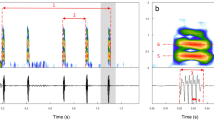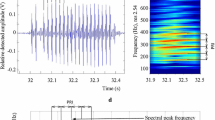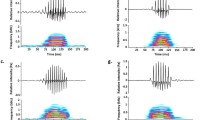Abstract
Many species of fishes use acoustic signals for a variety of purposes, and sciaenid are well-known producers of sound. The Southern King Weakfish (Macrodon atricuada- Sciaenidae) possesses sexually dimorphic bilateral sonic muscles used for sound production. The bilaterally paired muscles lie on the inner body wall of the male, surrounding the swimbladder. The Southern King Weakfish produces three different sounds: advertisement calls, disturbance calls and dual-knocks, these sounds were recorded from Rio de la Plata estuary, Uruguayan coastal waters and laboratory. The advertisement call, related to courtship, was recorded in the field and from spawning males in the laboratory. Disturbance calls were produced when captive M. atricauda were startled, chased with a net or grabbed by the tail. Disturbance calls consist of a burst of pulses produced at short intervals. In disturbance call interpulse interval increased and dominant frequency decreased linearly (P < 0.05), pulse duration did not change with fish size. M. atricauda start producing disturbance call at 14 cm LT (Total Length), but only individuals over than 25 cm LT were who produced the advertisement call. Dual-knocks, call compose of only two pulses together, was recorder only in captivity. Sounds are a valuable non-invasive tool for fisheries biologists can used to monitor on males in spawning populations.






Similar content being viewed by others
References
Aalbers SA, Drawbridge MA (2008) Spawning behavior and associated sound production of the white seabass Atractoscion nobilis. Trans Am Fish Soc 137:542–550. https://doi.org/10.1577/T04-058.1
Amorim MCP (2006) Diversity of sound production in fish. In: Ladich F, Collin SP, Moller P, Kapoor BG (eds) Communiation in fishes. Science Publishers, Enfield, pp 71–105
Amorim MCP (2008) Species differences in courtship acoustic signals among five Lake Malawi cichlid species (Pseudotropheus spp.). J Fish Biol 72:1355–1368
Amorim MCP, Vasconcelos RO, Fonseca PJ (2015) Fish sounds and mate choice. In: Ladich F (ed) Sound communication in fishes. Springer Verlag, Wien, pp 1–33
Bass AH, Chagnaud BP, Feng NI (2015) Comparative neurobiology of sound production in fishes. In: Ladich F (ed) Sound communication in fishes. Springer Verlag, Wien, pp 35–75
Bolgan M, O'Brien J, Picciulin M, Manning L, Gammell M (2017) Behaviour of Arctic charr Salvelinus alpinus during an induced mating season in captivity: how male relative size influences male behavioural investment and female preference over time. J Fish Biol 90:1479–1505. https://doi.org/10.1111/jfb.13244
Bolgan M, Amorim MCP, Fonseca PJ, Di Iorio L, Parmentier E (2018) Acoustic complexity of vocal fish communities: a field and controlled validation. Sci Rep 8(1):10559. https://doi.org/10.1038/s41598-018-28771-6
Borie A, Mok H, Chao N, Fine M (2014) Spatiotemporal variability and sound characterization in silver croaker Plagioscion squamosissimus (Sciaenidae) in the Central Amazon. PLoS One 9:e99326. https://doi.org/10.1371/journal.pone.0099326
Cardoso LG, Santos S, Haimovici M (2012) Differences in the otoliths support the distinction of the genus Macrodon into two species in the South-Western Atlantic Ocean. Mar Biodivers Rec 5:e93
Carvalho-Filho A, Santos S, Sampaio I (2010) Macrodon atricauda (Günther, 1880) (Perciformes: Sciaenidae), a valid species from the southwestern Atlantic, with comments on its conservation. Zootaxa 2519:48–58
Chao LN (1978) A basis for classifying Western Atlantic Sciaenidae (Teleostei: Perciformes). NOAA technical report circular 415. Washington DC: US Department of Commerce, National Oceanic and Atmospheric Administration, national marine fisheries service. 65pp
Connaughton MA, Taylor MH (1994) Seasonal cycles in the sonic muscles of the weakfish, Cynoscion regalis US Fish Bull 92: 697–703
Connaughton MA, Taylor MH (1995) Seasonal and daily cycles in sound production associated with spawning in the weakfish, Cynoscion regalis. Environ Biol Fish 42:233–240
Connaughton MA, Taylor MH (1996) Drumming, courtship and spawning behavior in captive weakfish, Cynoscion regalis. Copeia 1996:195–199
Connaughton MA, Fine ML, Taylor MH (1997) The effects of seasonal hypertrophy and atrophy on fiber morphology, metabolic substrate concentration and sound characteristics of the weakfish sonic muscle. J Exp Biol 200:2449–2457
Connaughton MA, Taylor MH, Fine ML (2000) Effects of fish size and temperature on weakfish disturbance calls: implications for the mechanism of sound generation. J Exp Biol 203:1503–1512
Connaughton MA, Fine ML, Taylor MH (2002) Weakfish sonic muscle: influence of size, temperature and season. J Exp Biol 205:2183–2188
Cousseau MB (1985) Los peces del Río de la Plata y de su Frente Marítimo. In: Yañez-Arancibia A (ed) In Fish community ecology in estuaries and coastal lagoons. Towards an ecosystem integration. UNAM Press, Mexico, pp 515–534
Fine ML, Parmentier E (2015) Mechanisms of fish sound production. In: Ladich F (ed) Sound communication in fishes, animal signals and communication 4. Springer, New York, pp 77–126. https://doi.org/10.1007/978-3-7091-1846-7-3
Fine ML, Winn HE, Olla B (1977) Communication in fishes. In: Sebeok T (ed) How animals communicate. Indiana University Press, Bloomington, pp 472–518
Fine ML, Malloy KL, King CB, Mitchell SL, Cameron TM (2001) Movement and sound generation by the toadfish swimbladder. J Comp Physiol A 187:371–379
Fine ML, Schrinel J, Cameron TM (2004) The effect of loading on disturbance sounds of the Atlantic croaker Micropogonius undulatus: air versus water. J Acoust Soc Am 116:1271–1275
Fish MP, Mowbray WH (1970) Sound of the Western North Atlantic fishes. Johns Hopkins Press, Baltimore
Fish JF, Cummings WC (1972) A 50-dB increase in sustained ambient noise from fish (Cynoscion xanthulus). J Acoust Soc Am 52(4B):1266–1270
Haimovici M, Vieira PC (1986) Captura e esforço na pesca de arrasto de fundo no litoral sul do Brasil, no período 1975–1984. Anais do IV Congresso Brasileiro de Engenharia de Pesca 2:15–234
Hammer Ǿ, Harper DAT, Ryan PD (2001) PAST: paleontological statistic software package for education and data analysis. Palaeontol Electron 4(1):1–9
Hawkins AD, Rasmussen KJ (1978) The calls of gadoid fishes. JMBA 58:891–911
Hill AV (1950) The dimensions of animals and their muscular dynamics. Sci Prog 38:209–230
Hill GL, Fine ML, Musick JA (1987) Ontogeny of the sexually dimorphic sonic muscle in three sciaenid species. Copeia 1987:708–713
Holt SA (2008) Distribution of red drum spawning sites identified by a towed hydrophone array. Trans Am Fish Soc 137(2):551–561
Holt J, Godbout R, Arnold CR (1981) Effects of temperature and salinity on egg hatching and larval survival of red drum Sciaenops ocellata. United States National Marine Fisheries Service Fishery Bulletin 79:569–573
Jaureguizar AJ, Milessi AC (2008) Assessing the sources of the fishing down marine food web process in the Argentinean-Uruguayan common fishing zone. Sci Mar 72:25–36
Ladich F (1997) Agonistic behaviour and significance of sounds in vocalizing fish. Mar Freshw Behav Physiol 29:87–108
Ladich F, Fine ML (2006) Sound-generating mechanisms in fishes: a unique diversity in vertebrates. In: Ladich F et al (eds) Communication in fishes. Science, Enfield, pp 3–43
Ladich F, Collin SP, Moller P, Kapoor BG (eds) (2006) Communication in fishes. Science, Enfield
Lagardère JP, Mariani A (2006) Spawning sounds in meager Argyrosomus regius in the Gironde estuary, France. J Fish Biol 69:1697–1708. https://doi.org/10.1111/j.1095-8649.2006.01237.x
Lin YC, Mok HK, Huang BQ (2007) Sound characteristics of big-snout croaker, Johnius macrorhynus (Sciaenidae). JASA 121:586–593. https://doi.org/10.1121/1.2384844
Lobel PS (2002) Diversity of fish spawning sounds and the application of passive acoustic monitoring. Bioacoustics 12:286–289
Lobel PS, Mann DA (1995) Spawning sounds of the damselfish, Dascyllus albisella (Pomacentridae), and relationship to male size. Bioacoustics 6:187–198
Locascio JV, Mann DA (2008) Diel periodicity of fish sound production in Charlotte Harbor, Florida. Trans Am Fish Soc 137:606–615. https://doi.org/10.1577/T06-069.1
Locascio JV, Mann DA (2011) Localization and source level estimates of black drum (Pogonias cromis) calls. J Acoust Soc Am 130:1868–1879. https://doi.org/10.1121/1.3621514
Luczkovich JJ, Sprague MW, Johnson SE, Paullinger RC (1999) Delimiting spawning areas of weakfish, Cynoscion regalis (family Sciaenidae) in Pamlico sound, North Carolina using passive hydroacoustic surveys. Bioacoustics 10:143–160
Luczkovich JJ, Mann DA, Rountree RA (2008) Passive acoustics as a tool in fisheries science. Trans Am Fish Soc 137:533–541. https://doi.org/10.1577/T06-258.1
Malavasi S, Collatuzzo S, Torricelli P (2008) Interspecific variation of acoustic signals in Mediterranean gobies (Perciformes, Gobiidae) comparative analysis and evolutionary outlook. Biol J Linn Soc 93:763–778
Mann DA, Lobel PS (1997) Propagation of damselfish (Pomacentridae) courtship sounds. JASA 101:3783–3379
Mazzoni D (2006) AUDACITY 1.2.6. Available at http://audacity.sourceforge.net/
Merriner JV (1976) Aspects of the reproductive biology of the weakfish, Cynoscion regalis (Sciaenidae), in North Carolina. US Fish Bull 74:18–26
Militelli MI, Macchi GJ (2004) Spawning and fecundity of king weakfish, Macrodon ancylodon, in the Rio de la Plata estuary, Argentina-Uruguay. JMBA 84:443–447
Militelli MI, Macchi GJ, Rodrigues K (2013) Comparative reproductive biology of Sciaenidae family species in the Río de La Plata and Buenos Aires coastal zone, Argentina. JMBA 93(2):413–423
Millot S, Vandewalle P, Parmentier E (2011) Sound production in red-bellied piranhas (Pygocentrus nattereri, Kner): an acoustical, behavioural and morphofunctional study. J Exp Biol 214(21):3613–3618
Mok HK, Gilmore RG (1983) Analysis of sound production in estuarine aggregations of Pogonias cromis, Bairdiella chrysoura, and Cynoscion nebulosus (Sciaenidae). Bull Inst Zool Acad Sin 22:157–186
Mok HK, Yu HY, Ueng JP, Wei RC (2009) Characterization of sounds of the Blackspotted croaker Protonibea diacanthus (Sciaenidae) and localization of its spawning sites in estuarine coastal waters of Taiwan. Zool Stud 48:325–333
Montie EW, Kehrer C, Yost J, Brenkert K (2016) Long-term monitoring of captive red drum Sciaenops ocellatus reveals that calling incidence and structure correlate with egg deposition. J Fish Biol 88:1776–1795
Montie EW, Hoover M, Kehrer C, Yost J, Brenkert K, O'Donnell T, Denson MR (2017) Acoustic monitoring indicates a correlation between calling and spawning in captive spotted seatrout (Cynoscion nebulosus). PeerJ 5:e2944. https://doi.org/10.7717/peerj.2944
Myrberg AA (1981) Sound communication and interception in fishes. In: Tavolga WN, Popper AN, Fay RR (eds) Hearing and sound communiction in fishes. Springer-Verlag, New York, pp 395–428
Nelson JS (2006) Fishes of the world. 4th ed. Hoboken (New Jersey, USA): John Wiley & Sons. Xix+601 p
Ono RD, Poss SG (1981) Structure and innervation of the swim bladder musculature in the weakfish, Cynoscion regalis (Teleostei: Sciaenidae). Can J Zool 60:1955–1967
Parmentier E, Fine ML (2016) Fish sound production. In: Suthers RA, Fitch T (eds) Handbook of auditory research. Springer, New York, pp 19–49
Parmentier E, Lecchini D, Frederich B, Brie C, Mann D (2009) Sound production in four damselfish (Dascyllus) species: phyletic relationships? Biol J Linn Soc 97:928–940. https://doi.org/10.1111/j.1095-8312.2009.01260.x
Parmentier E, Tock J, Falguière JC, Beauchaud M (2014) Sound production in Sciaenops ocellatus: preliminary study for the development of acoustic cues in aquaculture. Aquaculture 432:204–211
Phillips CT, Johnston CE (2009) Evolution of acoustic signals in Cyprinella: degree of similarity in sister species. J Fish Biol 74:120–132
Picculin M, Calcagno G, Sebastianutto L, Bonacito C, Codarin A, Costantini M, Ferrero EA (2012) Diagnostics of nocturnal calls of Sciaena umbra (L., fam. Sciaenidae) in a nearshore Mediterranean marine reserve. Bioacoustics 212:1–12
Picculin M, Bolgan M, Corò AB, Calcagno G, Malavasi S (2016) Sound production by the shi drum Umbrina cirrosa and comparison with the brown meagre Sciaena umbra: a passive acoustic monitoring perspective. J Fish Biol 88:1655–1660
Ramcharitar J, Gannon DP, Popper AN (2006) Bioacoustics of the family Sciaenidae (croakers and drumfishes). Trans Am Fish Soc 135:1409–1431
Rodrigues R, Santos S, Haimovici M, Saint-Paul U, Sampaio I, Schneider H (2014) Mitochondrial DNA reveals population structuring in Macrodon atricauda (Perciformes: Sciaenidae): a study covering the whole geographic distribution of the species in the southwestern Atlantic. Mitochondrial DNA 25(2):150–156
Rountree RA, Gilmore RG, Goudey CA, Hawkins AD, Luczkovich JJ, Mann DA (2006) Listening to fish: applications of passive acoustics to fisheries science. Fisheries 31:433–446
Santos S, Hrbek T, Farias IP, Schneider H, Sampaio I (2006) Population genetic structuring of the king weakfish, Macrodon ancylodon (Sciaenidae), in Atlantic coastal waters of South America: deep genetic divergence without morphological change. Mol Ecol 15:4361–4373
Saucier MH, Baltz DM (1993) Spawning site selection by spotted seatrout, Cynoscion nebulosus, and black drum, Pogonias cromis, in Luisiana. Environ Biol Fish 36:257–272
Schneider VR, Hasler AD (1960) Laute und Lauterzeugung bein Suesswassertrommler Aplodinotus grunniens Rafinesque (Sciaenidae, Pisces). Z vergl Physiol 43:499–517
Shao KT (2005) Taiwan fish database World Wide Web electronic publication version 2005/5. Available at http:// fishdb.sinica.edu.tw
Smith HM (1905) The drumming of the drum-fishes (Sciaenidae). Science 22:376–378
Sokal RR, Rohlf FJ (1995) Biometry: the principles and practice of statistics in biological research. W.H. Freeman and Company, New York, 850 p
Spanier E (1979) Aspects of species recognition by sounds in four species of damselfishes, genus Eupomacentrus (Pisces: Pomacentridae). Z Tierpsychol 51:301–316
Tavolga WN (1964) Sonic characteristics and mechanisms in marine fishes. In: Tavolga WN (ed) Marine bio-acoustics, vol 1. Pergamon, New York, pp 195–211
Tavolga WN (1980) Hearing and sound communication in fishes in relation to fisheries management. In: Bardach JE, Magnuson J, May RC, Reinhart JM (eds) Fish behavior and its use in the capture and culture of fishes (ICLARM Conference Proceedings 5, Manilla), pp 102–123
Tellechea SJ, Norbis W (2012) Sexual dimorphism in sound production and relationship between fish size and call characteristics in the striped weakfish Cynoscion guatucupa. Zool Stud 51:946–955
Tellechea SJ, Martinez C, Fine ML, Norbis W (2010a) Sound production in whitemouth croaker (Micropogonias furnieri – Sciaenidae) and relationship between fish size and disturbance call parameters. Environ Biol Fish 89:163–172
Tellechea SJ, Olsson D, Norbis W, Fine ML (2010b) Calls of the black drum (Pogonias cromis–Sciaenidae): geographical differences in sound production between northern and southern hemisphere populations. J Exp Zool A 315:48–55
Tellechea SJ, Fine ML, Norbis W (2017) Passive acoustic monitoring, development of disturbance calls and differentiation of disturbance and advertisement calls in the argentine croaker Umbrina canosai (Sciaenidae). J Fish Biol 90(4):1631–1643. https://doi.org/10.1111/jfb.13257
Ueng JP, Huang BQ, Mok HK (2007) Sexual differences in spawning sounds of the Japanese croaker Argyrosomus japonicus (Sciaenidae). Zool Stud 46:103–110
Vizziano D, Berois N (1990) Histologia del ovario de Macrodon ancylodon (Bloch y Schneider, 1801) Teleostei: Sciaenidae. Ovoge.nesis. Folículos post-ovulatorios. Atresia. Rev Bras Biol 50:523–536
Wainwright PC, Barton RC (1995) Scaling in the feeding mechanism of the largemouth bass (Micropterus salmoides): motor pattern. J Exp Biol 198:1161–1171
Winn HE (ed) (1964) The biological significance of fish sounds. Marine Bio-acoustics. Pergamon, New York
Winn HE (1972) Acoustic discrimination by the toadfish with comments on signal systems. In: Winn HE, Olla BL (eds) Behavior of Marine Animals: Current Perspectives in Research, Vol. 2. Vertebrates. Plenum Press, New York, pp 361–385
Acknowledgments
I would like to thank to MSc Daniela Olsson for her help in the fish handling and transport to the tanks on the boat and also the for their suggestions and improvement to the English text. Also to ANII (Agencia Nacional de Investigación e Innovación) through the National Research System (ANII–SIN–Uruguay) for support. This manuscript been approved by an Animal Care Committee of Uruguay: Comisión Honoraria de Experimentation Animal (CHEA), Universidad de la República, Montevideo, Uruguay.
Author information
Authors and Affiliations
Corresponding author
Additional information
Publisher’s note
Springer Nature remains neutral with regard to jurisdictional claims in published maps and institutional affiliations.
Rights and permissions
About this article
Cite this article
Tellechea, J.S. The acoustic behavior of Southern King Weakfish (Macrodon atricauda-Sciaenidae). Environ Biol Fish 102, 1253–1264 (2019). https://doi.org/10.1007/s10641-019-00902-6
Received:
Accepted:
Published:
Issue Date:
DOI: https://doi.org/10.1007/s10641-019-00902-6




